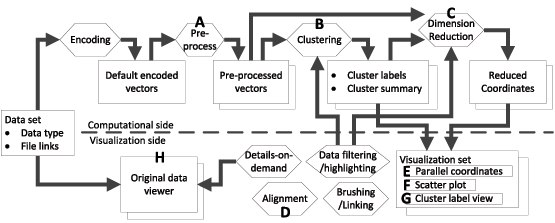Latest News and Events
FODAVA Testbed Software

Many of the modern data sets such as text and image data can be represented in high-dimensional vector spaces and have benefited from computational methods that utilize advanced techniques from numerical linear algebra. Visual analytics approaches have contributed greatly to data understanding and analysis due to their capability of leveraging humans' ability for quick visual perception. However, visual analytics targeting large-scale data such as text and image data has been challenging due to limited screen space in terms of both the numbers of data points and features to represent. Among various computational technique supporting visual analytics, dimension reduction and clustering have played essential roles by reducing these numbers in an intelligent way to visually manageable sizes. Given numerous dimension reduction and clustering techniques available, however, decision on choice of algorithms and their parameters becomes difficult.
The FODAVA testbed system is an interactive visual testbed system for dimension reduction and clustering in a large-scale high-dimensional data analysis. The testbed system enables users to apply various dimension reduction and clustering methods with different settings, visually compare the results from different algorithmic methods to obtain rich knowledge for the data and tasks at hand, and eventually choose the most appropriate path for a collection of algorithms and parameters.
The testbed can load image, raw text, and vector-encoded data types. It offers 4 different clustering and 17 different dimension reduction methods. Furthermore, the FODAVA testbed system is implemented in a flexible and modular way so that new methods and data types can be easily integrated.
The unique capability to align between different clustering and dimension reduction results facilitates their easy intuitive comparisons. Other than the currently-used basic algorithms such as Procrustes analysis and Hungarian algorithm, the testbed can be easily extended with other advanced alignment methods.
Finally, easy access to the advanced as well as traditional computational techniques from a practical application side will bring the recent advancements in data mining and machine learning areas to the real world via visual analytics approaches.
Software file links:
Testbed demo video (Chrome web browser may have issues)
Testbed software files
Installation Instructions



